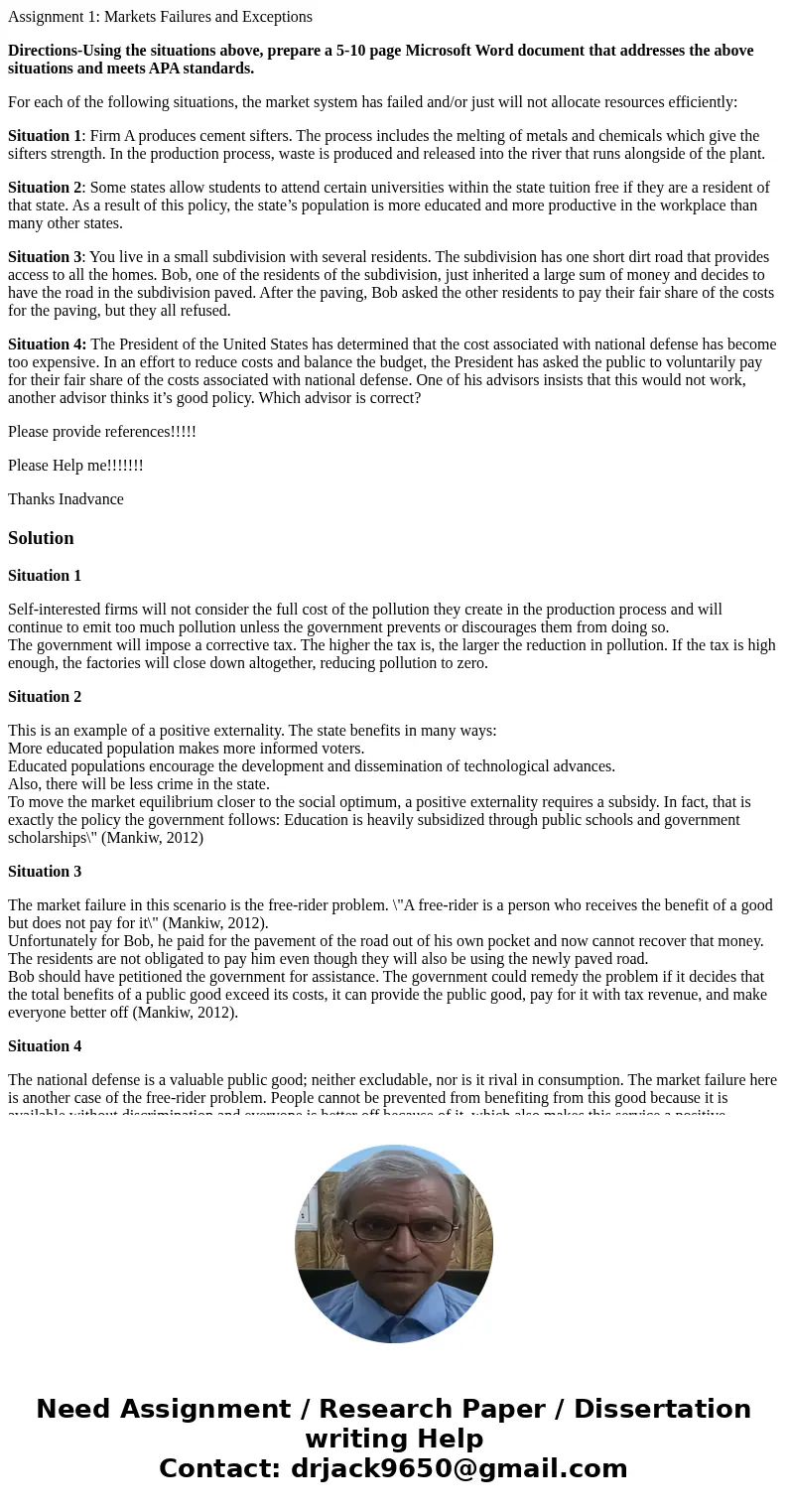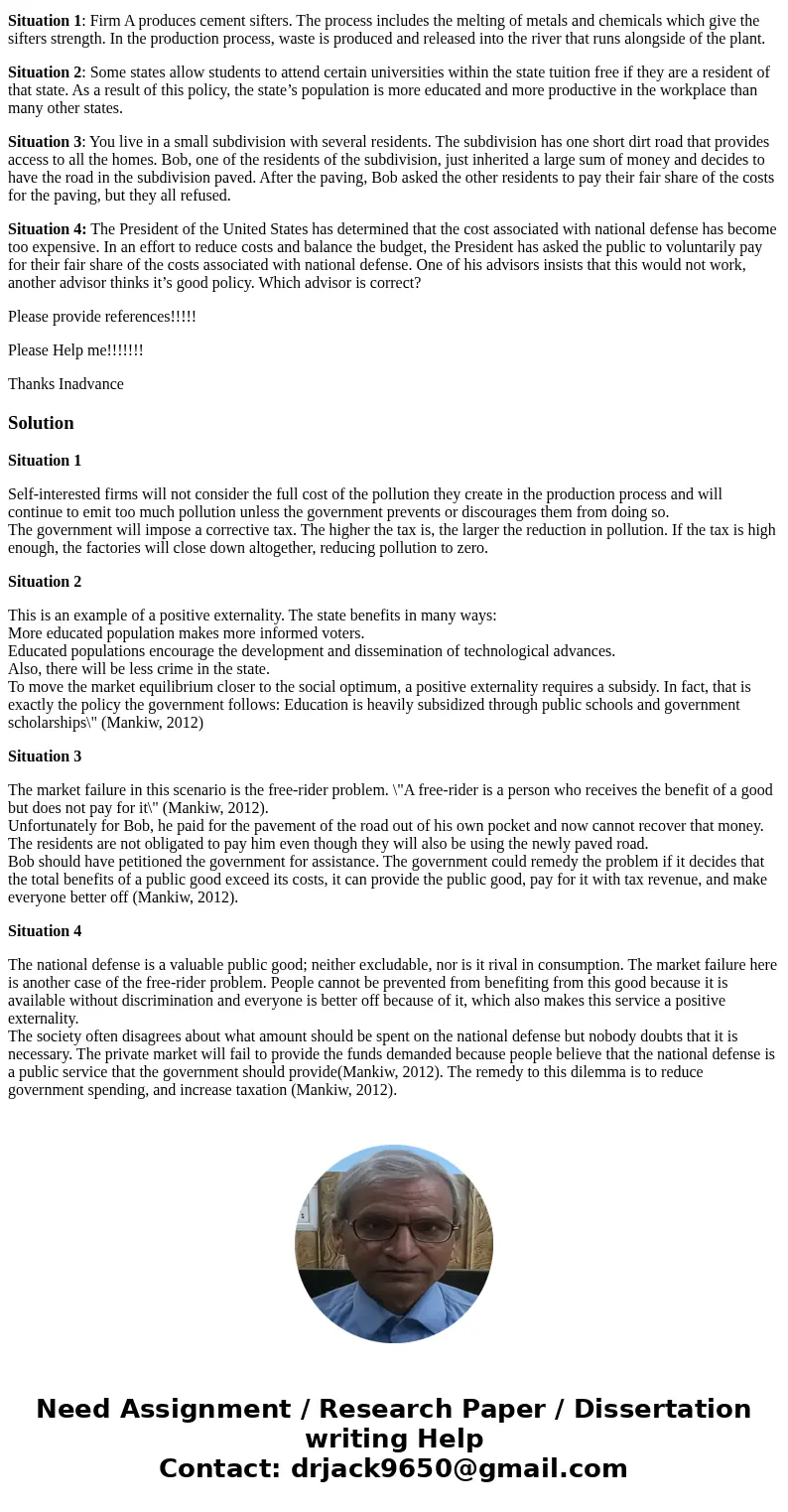Assignment 1 Markets Failures and Exceptions DirectionsUsing
Assignment 1: Markets Failures and Exceptions
Directions-Using the situations above, prepare a 5-10 page Microsoft Word document that addresses the above situations and meets APA standards.
For each of the following situations, the market system has failed and/or just will not allocate resources efficiently:
Situation 1: Firm A produces cement sifters. The process includes the melting of metals and chemicals which give the sifters strength. In the production process, waste is produced and released into the river that runs alongside of the plant.
Situation 2: Some states allow students to attend certain universities within the state tuition free if they are a resident of that state. As a result of this policy, the state’s population is more educated and more productive in the workplace than many other states.
Situation 3: You live in a small subdivision with several residents. The subdivision has one short dirt road that provides access to all the homes. Bob, one of the residents of the subdivision, just inherited a large sum of money and decides to have the road in the subdivision paved. After the paving, Bob asked the other residents to pay their fair share of the costs for the paving, but they all refused.
Situation 4: The President of the United States has determined that the cost associated with national defense has become too expensive. In an effort to reduce costs and balance the budget, the President has asked the public to voluntarily pay for their fair share of the costs associated with national defense. One of his advisors insists that this would not work, another advisor thinks it’s good policy. Which advisor is correct?
Please provide references!!!!!
Please Help me!!!!!!!
Thanks Inadvance
Solution
Situation 1
Self-interested firms will not consider the full cost of the pollution they create in the production process and will continue to emit too much pollution unless the government prevents or discourages them from doing so.
The government will impose a corrective tax. The higher the tax is, the larger the reduction in pollution. If the tax is high enough, the factories will close down altogether, reducing pollution to zero.
Situation 2
This is an example of a positive externality. The state benefits in many ways:
More educated population makes more informed voters.
Educated populations encourage the development and dissemination of technological advances.
Also, there will be less crime in the state.
To move the market equilibrium closer to the social optimum, a positive externality requires a subsidy. In fact, that is exactly the policy the government follows: Education is heavily subsidized through public schools and government scholarships\" (Mankiw, 2012)
Situation 3
The market failure in this scenario is the free-rider problem. \"A free-rider is a person who receives the benefit of a good but does not pay for it\" (Mankiw, 2012).
Unfortunately for Bob, he paid for the pavement of the road out of his own pocket and now cannot recover that money. The residents are not obligated to pay him even though they will also be using the newly paved road.
Bob should have petitioned the government for assistance. The government could remedy the problem if it decides that the total benefits of a public good exceed its costs, it can provide the public good, pay for it with tax revenue, and make everyone better off (Mankiw, 2012).
Situation 4
The national defense is a valuable public good; neither excludable, nor is it rival in consumption. The market failure here is another case of the free-rider problem. People cannot be prevented from benefiting from this good because it is available without discrimination and everyone is better off because of it, which also makes this service a positive externality.
The society often disagrees about what amount should be spent on the national defense but nobody doubts that it is necessary. The private market will fail to provide the funds demanded because people believe that the national defense is a public service that the government should provide(Mankiw, 2012). The remedy to this dilemma is to reduce government spending, and increase taxation (Mankiw, 2012).


 Homework Sourse
Homework Sourse